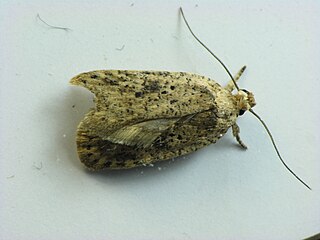| Gonioterma compressa | |
|---|---|
| Scientific classification | |
| Kingdom: | |
| Phylum: | |
| Class: | |
| Order: | |
| Family: | |
| Genus: | |
| Species: | G. compressa |
| Binomial name | |
| Gonioterma compressa (Walsingham, 1913) | |
| Synonyms | |
| |
Gonioterma compressa is a moth in the family Depressariidae. It was described by Lord Walsingham in 1913. It is found in Venezuela and Mexico (Tabasco). [1]

Moths comprise a group of insects related to butterflies, belonging to the order Lepidoptera. Most lepidopterans are moths, and there are thought to be approximately 160,000 species of moth, many of which have yet to be described. Most species of moth are nocturnal, but there are also crepuscular and diurnal species.

Depressariidae is a family of moths. It has formerly been treated as a subfamily of Gelechiidae, but is now recognised as a separate family, comprising about 2300 species worldwide.

Thomas de Grey, 6th Baron Walsingham, of Merton Hall, Norfolk, was an English politician and amateur entomologist.
The wingspan is about 18 mm. The forewings are pale stone grey, with pale rust-brown markings which tend to throw up rather more intensely coloured rust-brown scales along their margins. These consist of first, an irregular, large, dorsal patch covering two-fifths of the dorsum, throwing out a slight angle on the fold, and a stronger projecting angle upward nearly to the costa, but not reaching the base. Secondly, a broken and rather outwardly oblique fasciate shade a little beyond the middle, forming a costal spot, an inwardly projecting patch at the end of the cell, and a short length-spot on the dorsum, connected to the cell-spot by a narrow sinuate line. Thirdly, a costal spot before the apex, connected with the tornus by an outwardly convex narrow line of spots on the veins. Around the apex and termen is also a line of semidetached brown spots. The costa is narrowly tinged with ochreous. The hindwings are pale brownish grey. [2]

The wingspan of a bird or an airplane is the distance from one wingtip to the other wingtip. For example, the Boeing 777-200 has a wingspan of 60.93 metres, and a wandering albatross caught in 1965 had a wingspan of 3.63 metres, the official record for a living bird. The term wingspan, more technically extent, is also used for other winged animals such as pterosaurs, bats, insects, etc., and other fixed-wing aircraft such as ornithopters. In humans, the term wingspan also refers to the arm span, which is distance between the length from one end of an individual's arms to the other when raised parallel to the ground at shoulder height at a 90º angle. Former professional basketball player Manute Bol stands at 7 ft 7 in (2.31 m) and owns one of the largest wingspans at 8 ft 6 in (2.59 m).
